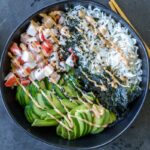Imagine vibrant, flavorful Paleo meals prepared in minutes, using only five ingredients or less. Forget complicated recipes and lengthy grocery lists; this guide unlocks the secret to effortless, healthy eating. Dive into a world of quick weeknight dinners, satisfying breakfasts, and delightful desserts, all crafted with the simplicity and nutritional power of the Paleo diet. Each recipe is designed to maximize flavor and minimize effort, making healthy eating a breeze, not a chore.
We’ll explore a diverse range of Paleo recipes, categorized for convenience. From protein-packed post-workout meals to refreshing salads and easy breakfasts, we’ve got you covered. Learn how to cleverly substitute ingredients, create delicious variations, and understand the nutritional benefits of each dish. This isn’t just about recipes; it’s about embracing a healthier lifestyle with minimal fuss and maximum taste.
Paleo Recipe Variations

This section explores the versatility of paleo cooking by showcasing three variations of a simple chicken and vegetable stir-fry, each adhering to a five-ingredient limit. We will examine how altering the vegetables impacts the nutritional profile and demonstrate the ease of ingredient substitution while maintaining the recipe’s core flavor and nutritional value.
Chicken and Vegetable Stir-Fry Variations
The following table presents three variations of a basic paleo chicken and vegetable stir-fry, each highlighting different vegetable combinations and their resulting nutritional profiles. Each recipe uses approximately 1 pound of boneless, skinless chicken breast, 1 tablespoon of coconut aminos, and 1 tablespoon of coconut oil.
| Variation | Vegetables | Nutritional Highlights | Visual Description |
|---|---|---|---|
| Variation 1: Broccoli & Bell Pepper Stir-fry | 1 head of broccoli, 1 red bell pepper | High in Vitamin C (from bell pepper), Vitamin K (from broccoli), and fiber. Offers a good source of antioxidants. | Imagine vibrant green broccoli florets interspersed with strips of bright red bell pepper, glistening with coconut oil. The chicken pieces are tender and evenly coated in a dark, glossy sauce. |
| Variation 2: Asparagus & Zucchini Stir-fry | 1 bunch of asparagus, 2 medium zucchini | Rich in folate (from asparagus), potassium (from zucchini), and vitamin A (from both). Provides a lighter, more refreshing flavor profile. | Picture slender spears of bright green asparagus alongside pale green zucchini ribbons. The chicken is subtly infused with the delicate flavors of the vegetables, creating a visually appealing and light stir-fry. |
| Variation 3: Cauliflower & Carrot Stir-fry | 1 head of cauliflower, 2 large carrots | High in Vitamin A (from carrots), fiber (from both), and choline (from cauliflower). Offers a slightly sweeter taste compared to the other variations. | Imagine creamy white cauliflower florets and vibrant orange carrot slices, creating a visually appealing contrast. The chicken is infused with a slightly sweet flavor from the carrots, creating a comforting and warm stir-fry. |
Nutritional Profile Comparisons
While all three variations provide a good source of lean protein from the chicken, the vegetable choices significantly influence the vitamin and mineral content. Variation 1 offers a higher concentration of Vitamins C and K, while Variation 2 excels in folate and potassium. Variation 3 provides a significant amount of Vitamin A and fiber. The choice of vegetables allows for customization to meet individual nutritional needs and preferences.
Ingredient Substitution in Paleo Recipes
Substituting ingredients within a paleo recipe requires careful consideration to maintain both flavor and nutritional balance. For example, if bell peppers are unavailable in the Broccoli & Bell Pepper Stir-fry, substituting with a similar-colored and textured vegetable like yellow squash would maintain the visual appeal and offer a comparable level of sweetness. Replacing coconut aminos with a different sauce like a homemade lemon-herb dressing would alter the flavor profile but would still keep the recipe paleo-friendly, provided the substitute contains only paleo-approved ingredients. The key is to select substitutes that share similar textures and flavor profiles to maintain the integrity of the dish.
Paleo Recipe Focus
Fueling your body after an intense workout requires a strategic approach, especially when following a paleo diet. These recipes prioritize lean protein sources, healthy fats, and readily available carbohydrates for optimal muscle recovery and replenishment. They’re designed to be quick, easy, and delicious, making post-workout nutrition a breeze.
High-Protein Paleo Recipes (5 Ingredients or Less)
These three recipes offer diverse flavor profiles while remaining true to paleo principles and utilizing a minimal number of ingredients. Each recipe is packed with protein to aid in muscle repair and growth after physical exertion.
- Grilled Salmon with Asparagus: A classic combination of lean protein and nutrient-rich vegetables. Simply season salmon fillets with salt and pepper, grill alongside asparagus spears drizzled with olive oil, and enjoy.
- Chicken and Avocado Salad: This vibrant salad provides a refreshing post-workout meal. Combine shredded cooked chicken breast, diced avocado, cherry tomatoes, a squeeze of lime juice, and a sprinkle of salt and pepper.
- Steak and Sweet Potato: A hearty and satisfying option, this pairing offers sustained energy. Season a lean steak with salt and pepper, grill or pan-fry, and serve alongside baked or roasted sweet potato cubes.
Step-by-Step: Grilled Salmon with Asparagus
This recipe highlights the simplicity and effectiveness of a protein-focused paleo meal. The visual appeal of the glistening salmon and vibrant green asparagus is as enticing as the satisfying taste.
- Preparation: Preheat your grill to medium-high heat. Rinse and trim the asparagus spears, then toss them lightly with 1 tablespoon of olive oil, salt, and pepper. Pat the salmon fillets dry with paper towels and season generously with salt and pepper.
- Grilling: Place the asparagus spears on one side of the grill and the salmon fillets on the other. Grill the asparagus for about 5-7 minutes, turning occasionally, until tender-crisp. The salmon will require approximately 4-6 minutes per side, depending on thickness, until it flakes easily with a fork. The cooked salmon will exhibit a beautiful, slightly caramelized exterior and a tender, opaque interior.
- Serving: Remove both the asparagus and salmon from the grill. The asparagus will have a bright, vibrant green color, slightly softened yet maintaining a pleasant bite. Arrange the grilled salmon on a plate and place the asparagus alongside. The finished dish presents a visually appealing contrast of colors and textures.
The Importance of Protein in a Paleo Diet
Protein is crucial for muscle repair and growth, particularly after intense physical activity. A paleo diet, naturally rich in lean protein sources like fish, poultry, and meat, provides the building blocks for muscle tissue regeneration. These recipes directly contribute to this process, ensuring your body has the necessary resources to recover effectively and build strength. Adequate protein intake also supports overall health by maintaining healthy bones, promoting satiety, and regulating various metabolic functions. The recipes provided offer convenient and delicious ways to incorporate this essential macronutrient into a post-workout paleo routine.
Paleo Recipe Focus
Jumpstart your day with these vibrant and nourishing paleo breakfasts, each crafted with five ingredients or less for ultimate convenience and flavor. These recipes prioritize whole, unprocessed foods to fuel your body and mind for sustained energy and focus throughout the morning. They are designed to be both quick to prepare and satisfying, helping you avoid mid-morning energy slumps and unhealthy snacking.
Quick & Easy Paleo Breakfasts (5 Ingredients or Less)
These recipes offer a delicious and efficient way to enjoy a paleo breakfast without spending hours in the kitchen. Each recipe is designed to provide a balanced mix of protein, healthy fats, and natural sugars for sustained energy and satiety.
| Recipe Name | Ingredients | Preparation | Benefits |
|---|---|---|---|
| Coconut Yogurt with Berries & Nuts | Full-fat coconut yogurt, mixed berries (strawberries, blueberries, raspberries), chopped almonds or walnuts, a drizzle of honey (optional), a sprinkle of cinnamon (optional) | Combine yogurt, berries, and nuts in a bowl. Drizzle with honey and sprinkle with cinnamon, if desired. | Provides sustained energy from healthy fats in coconut yogurt and nuts, antioxidants from berries, and natural sweetness for a satisfying breakfast that keeps you full until lunchtime. |
| Paleo Egg Muffins | Eggs, chopped spinach, diced bell peppers, crumbled bacon or sausage (optional), shredded cheese (optional) | Whisk eggs. Mix in spinach, peppers, and optional bacon/sausage and cheese. Pour into muffin tins and bake at 350°F (175°C) for 15-20 minutes. | High in protein from eggs and optional bacon/sausage, providing sustained energy and satiety. The vegetables add vitamins and minerals for a nutritious and energizing start to the day. |
| Avocado & Egg Toast | Avocado, 2 eggs, sliced tomato, salt and pepper, paleo bread or sweet potato slices | Toast paleo bread or sweet potato slices. Mash avocado on toast. Fry or poach eggs and place on top of avocado. Add sliced tomato, salt, and pepper. | Healthy fats from avocado provide sustained energy and help regulate blood sugar levels, preventing energy crashes. Eggs offer high-quality protein for satiety and muscle building. The tomato adds vitamins and a refreshing element. |
Challenges and Solutions for Sticking to a Paleo Breakfast Routine
Maintaining a consistent paleo breakfast routine can present some challenges. Understanding these challenges and having proactive solutions in place is key to long-term success.
The most common challenges include time constraints, lack of meal prep, and finding appealing and easy recipes. To overcome these, consider prepping ingredients ahead of time (e.g., chopping vegetables on the weekend), keeping simple, readily available ingredients on hand (like coconut yogurt and berries), and utilizing quick-cooking methods like microwaving or baking in advance for grab-and-go options. Finding a variety of recipes that appeal to your palate is also crucial to prevent monotony and maintain adherence. For example, rotating between the three recipes above can provide a good starting point for variety. If time is a major constraint, consider preparing larger batches of egg muffins or overnight oats on the weekend to have quick breakfast options readily available throughout the week.
Unlocking the potential of Paleo cooking doesn’t require hours in the kitchen or a lengthy ingredient list. This collection of five-ingredient-or-less recipes proves that healthy eating can be both simple and incredibly satisfying. By mastering the art of ingredient substitution and understanding basic nutritional principles, you can create a personalized Paleo journey tailored to your tastes and preferences. Embrace the simplicity, savor the flavors, and enjoy the health benefits of this streamlined approach to Paleo cuisine. The journey to a healthier you starts with one delicious, five-ingredient meal.
Question Bank
Can I adapt these recipes to accommodate allergies or dietary restrictions?
Yes, many substitutions are possible. Always check ingredient labels and ensure any replacements align with your dietary needs. For example, nut-free alternatives can be substituted for those with nut allergies.
How do I store leftovers from these Paleo recipes?
Store leftovers in airtight containers in the refrigerator for up to 3-4 days. Always allow food to cool completely before refrigerating.
Are these recipes suitable for beginners?
Absolutely! The simplicity of these recipes makes them ideal for beginners to the Paleo diet or those new to cooking.
Can I freeze these recipes?
Many of these recipes freeze well. It’s best to freeze them in individual portions for easy reheating. Check the specific recipe notes for freezing guidelines.


